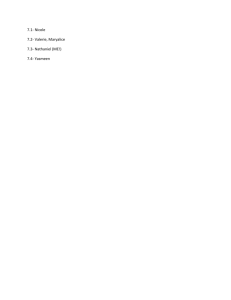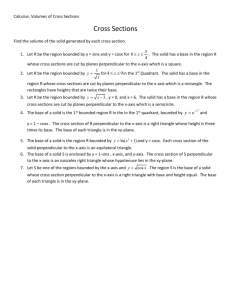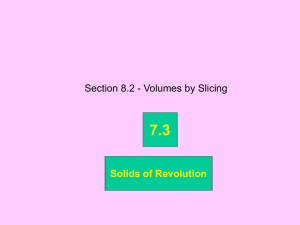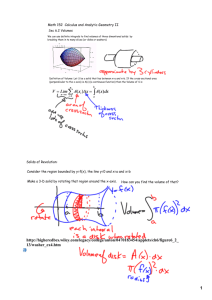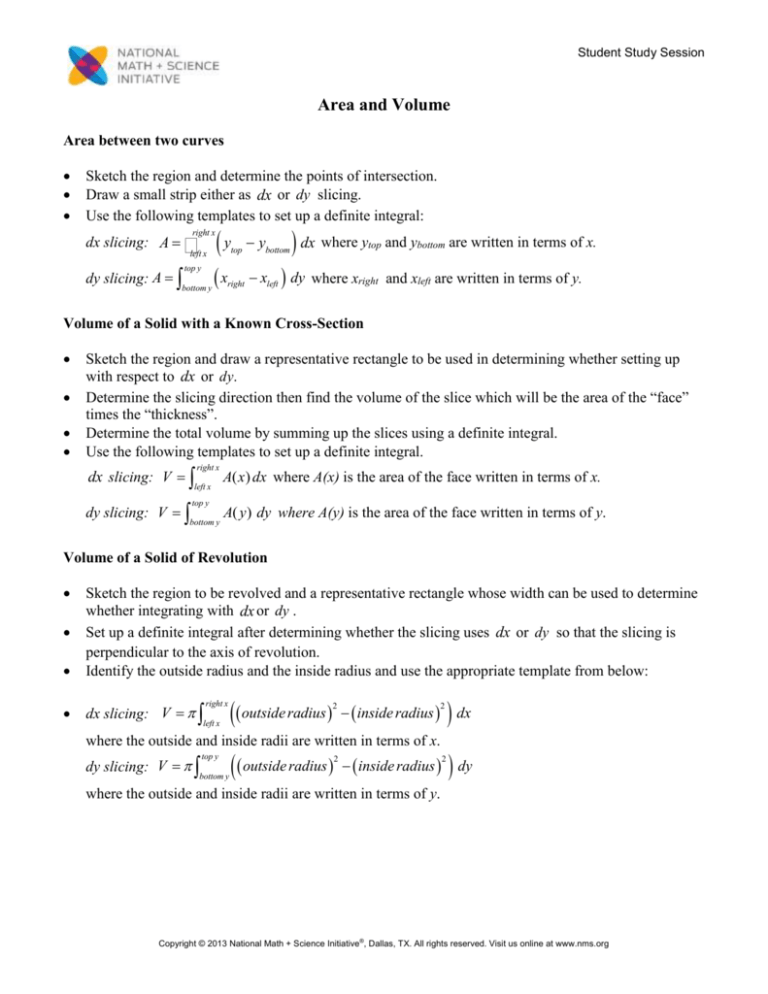
Student Study Session
Area and Volume
Area between two curves
Sketch the region and determine the points of intersection.
Draw a small strip either as dx or dy slicing.
Use the following templates to set up a definite integral:
dx slicing: A = ò
left x
dy slicing: A
(y
- ybottom dx where ytop and ybottom are written in terms of x.
x
xleft dy where xright and xleft are written in terms of y.
right x
top y
bottom y
top
right
)
Volume of a Solid with a Known Cross-Section
Sketch the region and draw a representative rectangle to be used in determining whether setting up
with respect to dx or dy.
Determine the slicing direction then find the volume of the slice which will be the area of the “face”
times the “thickness”.
Determine the total volume by summing up the slices using a definite integral.
Use the following templates to set up a definite integral.
right x
dx slicing: V left x A( x) dx where A(x) is the area of the face written in terms of x.
dy slicing: V
top y
bottom y
A( y ) dy where A(y) is the area of the face written in terms of y.
Volume of a Solid of Revolution
Sketch the region to be revolved and a representative rectangle whose width can be used to determine
whether integrating with dx or dy .
Set up a definite integral after determining whether the slicing uses dx or dy so that the slicing is
perpendicular to the axis of revolution.
Identify the outside radius and the inside radius and use the appropriate template from below:
dx slicing: V
right x
left x
outside radius
2
inside radius
2
where the outside and inside radii are written in terms of x.
dy slicing: V
top y
bottom y
outside radius
2
inside radius
2
dx
dy
where the outside and inside radii are written in terms of y.
Copyright © 2013 National Math + Science Initiative®, Dallas, TX. All rights reserved. Visit us online at www.nms.org
Areas and Volumes
Student Study Session
Multiple Choice
1. (calculator not allowed)
The region enclosed by the x-axis, the line x 3 , and the curve y x is rotated about the x-axis.
What is the volume of the solid generated?
3
2 3
9
(C)
2
(D) 9
36 3
(E)
5
(A)
(B)
2. (calculator not allowed)
x
The area of the region bounded by the lines x 0, x 2, and y 0 and the curve y e 2 is
(A)
(B)
(C)
(D)
(E)
e 1
2
e 1
2(e 1)
2e 1
2e
Copyright © 2013 National Math + Science Initiative®, Dallas, TX. All rights reserved. Visit us online at www.nms.org
Areas and Volumes
Student Study Session
3. (calculator not allowed)
The region bounded by the x-axis and the part of the graph of y cos x between x
is separated into two regions by the line x k . If the area of the region for
the area of the region for k x
2
2
2
and x
2
x k is three times
, then k
1
(A) arcsin
4
1
(B) arcsin
3
(C)
6
(D)
4
(E)
3
4. (calculator allowed)
The base of a solid is the region in the first quadrant bounded by the y-axis, the graph of y tan 1 x,
the horizontal line y 3, and the vertical line x 1. For this solid, each cross section perpendicular
to the x-axis is a square. What is the volume of the solid?
(A)
(B)
(C)
(D)
(E)
2.561
6.612
8.046
8.755
20.773
5. (calculator allowed)
What is the area enclosed by the curves y x3 8 x 2 18 x 5 and y x 5?
(A)
(B)
(C)
(D)
(E)
10.667
11.833
14.583
21.333
32
Copyright © 2013 National Math + Science Initiative®, Dallas, TX. All rights reserved. Visit us online at www.nms.org
Areas and Volumes
Student Study Session
6. (calculator allowed)
The regions A, B , and C in the figure above are bounded by the graph of the function f and the
x axis. If the area of each region is 2, what is the value of
f x 1 dx ?
3
3
(A) 2
(B) 1
(C) 4
(D) 7
(E) 12
Copyright © 2013 National Math + Science Initiative®, Dallas, TX. All rights reserved. Visit us online at www.nms.org
Areas and Volumes
Student Study Session
Free Response
7. (calculator allowed)
In the figure above, R, is the shaded region in the first quadrant bounded by the graph of
y 4 ln(3 x) , the horizontal line y 6 , and the vertical line x 2.
(a) Find the area of R.
(b) Find the volume of the solid generated when R is revolved about the horizontal line y 8 .
(c) The region R is the base of a solid. For this solid, each cross section perpendicular to the x-axis is
a square. Find the volume of the solid.
Copyright © 2013 National Math + Science Initiative®, Dallas, TX. All rights reserved. Visit us online at www.nms.org
Areas and Volumes
Student Study Session
8. (calculator not allowed)
The functions f and g are given by f ( x) x and g ( x) 6 x. Let R be the region bounded by
the x-axis and the graphs of f and g , as shown in the figure above.
(a) Find the area of R.
(b) The region R is the base of a solid. For each y, where 0 y 2, the cross section of the solid
taken perpendicular to the y-axis is a rectangle whose base lies in R and whose height is 2y .
Write, but do not evaluate, an integral expression that gives the volume of the solid.
(c) There is a point P on the graph of f at which the line tangent to the graph of f is perpendicular
to the graph of g . Find the coordinates of point.
Copyright © 2013 National Math + Science Initiative®, Dallas, TX. All rights reserved. Visit us online at www.nms.org
Areas and Volumes
Student Study Session
9. (calculator allowed)
Let R be the region in the first and second quadrants bounded above by the graph of y
20
and
1 x2
below by the horizontal line y = 2.
(a) Find the area of R.
(b) Find the volume generated when R is rotated about the x-axis.
(c) The region R is the base of a solid. For this solid, the cross sections perpendicular to the x-axis are
semicircles. Find the volume of this solid.
Copyright © 2013 National Math + Science Initiative®, Dallas, TX. All rights reserved. Visit us online at www.nms.org
Areas and Volumes
Student Study Session
10. (calculator not allowed)
Let
be the line tangent to the graph of y x n at the point (1, 1), where n > 1, as shown above.
(a) Find
1
0
x n dx in terms of n.
(b) Let T be the triangular region bounded by
1
T is
.
2n
, the x-axis, and the line x = 1. Show that the area of
(c) Let S be the region bounded by the graph of y x n , the line , and the x-axis. Express the area of
S in terms of n and determine the value of n that maximizes the area of S.
Copyright © 2013 National Math + Science Initiative®, Dallas, TX. All rights reserved. Visit us online at www.nms.org
Areas and Volumes
Student Study Session
11. (calculator allowed) (2008 AB1/BC1)
Let R be the region bounded by the graphs of y sin( x) and y x3 4 x , as shown in the figure
above.
(a) Find the area of R.
(b) The horizontal line y 2 splits the region R into two parts. Write, but do not evaluate, an
integral expression for the area of the part of R that is below this horizontal line.
(c) The region R is the base of a solid. For this solid, each cross section perpendicular to the x-axis is
a square. Find the volume of this solid.
(d) The region R models the surface of a small pond. At all points in R at a distance x from the y-axis,
the depth of the water is given by h( x) 3 x . Find the volume of water in the pond.
Copyright © 2013 National Math + Science Initiative®, Dallas, TX. All rights reserved. Visit us online at www.nms.org

